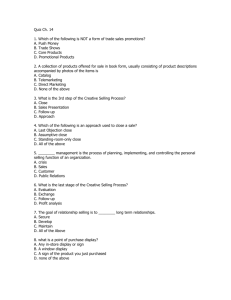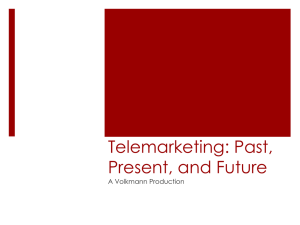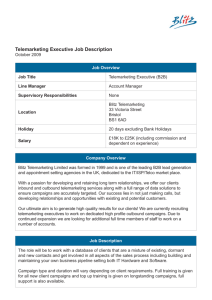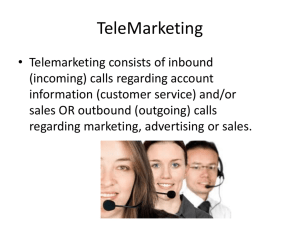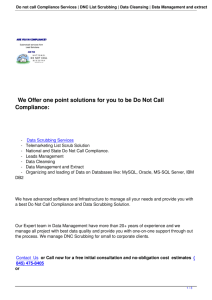Telemarketing
advertisement
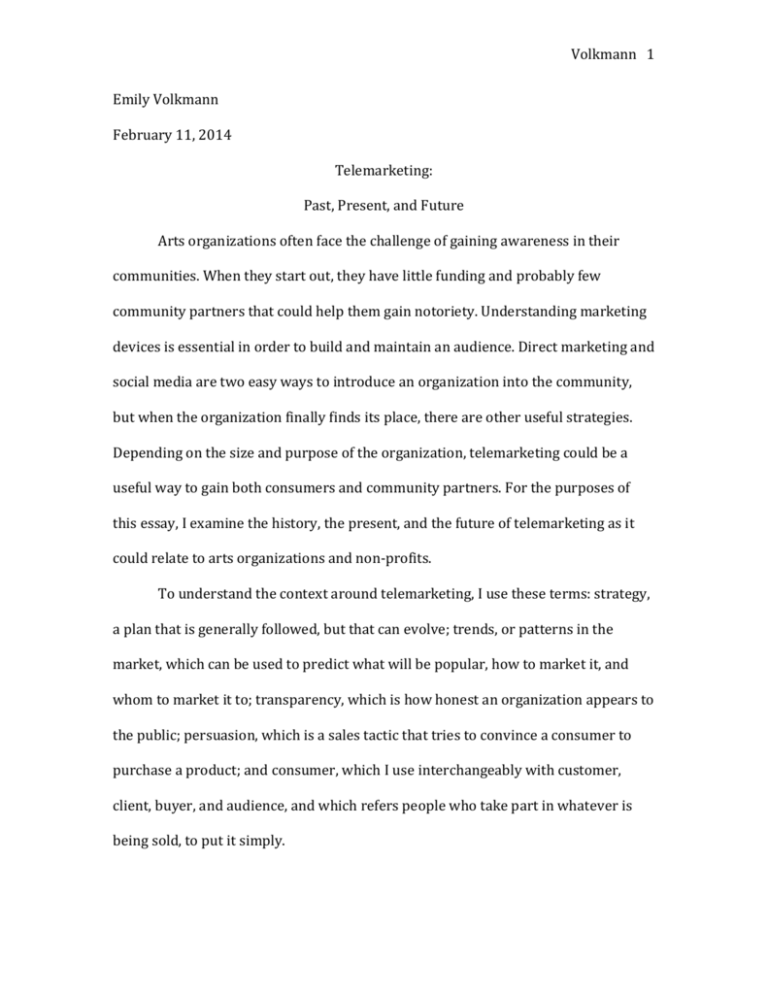
Volkmann 1 Emily Volkmann February 11, 2014 Telemarketing: Past, Present, and Future Arts organizations often face the challenge of gaining awareness in their communities. When they start out, they have little funding and probably few community partners that could help them gain notoriety. Understanding marketing devices is essential in order to build and maintain an audience. Direct marketing and social media are two easy ways to introduce an organization into the community, but when the organization finally finds its place, there are other useful strategies. Depending on the size and purpose of the organization, telemarketing could be a useful way to gain both consumers and community partners. For the purposes of this essay, I examine the history, the present, and the future of telemarketing as it could relate to arts organizations and non-profits. To understand the context around telemarketing, I use these terms: strategy, a plan that is generally followed, but that can evolve; trends, or patterns in the market, which can be used to predict what will be popular, how to market it, and whom to market it to; transparency, which is how honest an organization appears to the public; persuasion, which is a sales tactic that tries to convince a consumer to purchase a product; and consumer, which I use interchangeably with customer, client, buyer, and audience, and which refers people who take part in whatever is being sold, to put it simply. Volkmann 2 One of the most noticeable forms of marketing, telemarketing has been employed by many companies as a means to make sales. By definition, telemarketing is “marketing conducted over the telephone” (WiseGeek.com, 2014). This marketing strategy began as soon as phones became available because phones made it so easy for salespeople to contact their customers. But it was not until 1960 that telemarketing became relied upon, because AT&T developed a “bulk discounted call service” that enabled a cheaper way to make long-distance outbound calls (Johnson & Meiners, 1987, p. 65). Telemarketing gained popularity so quickly because of its ability to cut down both cost and time for businesses. As a part of direct marketing, telemarketing is a “special kind of marketing approach” because the message is tailored, to the point, and goes directly into the ear of the customer— if he or she is willing to hear it (Johnson & Meiners, 1987, p. 66). There are two distinct types of traditional telemarketing: inbound and outbound. Inbound telemarketing involves the prospective client or customer calling the company. For example, calling a toll-free 800 number that appears in other advertisements is a form of inbound telemarketing. Outbound telemarketing is more obvious to the consumer, and often unwanted. Customers are called directly, often at home and approached for a sale (Johnson & Meiners, 1987, p. 67). Customers who are called are often targeted, and the salesperson on the other end of the line could have detailed information about past purchases or other personal details. Of course, telemarketing is not always about making a sale to someone at home. Sometimes businesses will call other businesses in order to make lasting sale Volkmann 3 or a partnership, but for the purposes of this paper, I will mainly focus on telemarketing to the average consumer. In order for this technique to be effective, it is vital for telemarketers to be skilled salespeople, because unlike face-to-face contact, the only impression of the product the consumer will get is from the salesperson’s voice; the caller’s ability to persuade the customer into buying the product is key. Studies have been done to better understand how the consumer reacts to over the phone marketing in order to produce better results. One such study concluded that the “salesperson is a critical component of the telemarketing sales process” and that the subjects of the study continued to think about his or her motives and demeanor (Hu, Munch, & Toncar, 1994, p. 54). While it is appropriate for the salesperson to explain the product and message of the business, the question of credibility was at the forefront of most customers’ minds. Because of this consideration, marketers need to seriously consider whom they put on the phone, because even though someone might be a great at making sales in person, he or she might fall flat through the wires. Unlike other forms of marketing, telemarketing often feels intrusive because it allows businesses to contact potential consumers in their homes and without permission. Often, telemarketing calls are “cold calls”, which means that they are calling someone who has not requested being contacted. Many view telemarketing as a scam, and for good reason. There are numerous examples of people receiving phone calls telling them they have won something, but in order to claim the prize, they have to submit personal information, like a social security number (Federal Trade Commission, 2000). In the past few years, measures have been taken to Volkmann 4 restrict the amount of contact telemarketers can try to obtain. Beginning in 1991, the public was becoming so frustrated with telemarketing phone calls that Congress passed a law restricting the hours that telemarketers were allowed to call. A further step was instituting a “do-not-call” list in 2001 (WiseGeek.com, 2014). There are other aspects to telemarketing, however, than cold calls and scams. Another part of telemarketing involves fundraising, in which case the person at the end of the line is probably already a consumer of the telemarketer’s goods. Contacting customers voice-to-voice might be a more effective method of raising money than sending out mailings. In the end, the salesperson has one goal: to get the consumer to buy into whatever he or he is selling. In order to do so, telemarketers take several key steps. First, they must build rapport and earn the consumer’s trust so they can build a relationship over the phone. Then, they can explain the product and why it is so crucial that the consumer buys it. This segment is the main part of the sales call, as it carries the organization’s message. Finally, telemarketers must secure a commitment from the consumer, thus solidifying the relationship and making a sale (Hu, Munch, and Toncar, 1994, p. 48). An important consideration for many businesses that want to use telemarketing is transparency. In any marketing campaign, it is important that the company’s image is consistent and appropriate. Because the end goal of marketing is usually trying to bring in more consumers or to sell more product, it is especially important to remember to be as ethical as possible, especially for non-profit organizations (SAGE, 2011, p. 73). Volkmann 5 As new technologies, especially mobile technologies, become more widely used, some traditional marketing strategies are falling by the wayside. In fact, McLeish (2011) states that traditional marketing “can no longer be safely recommended” (McLeish, 2011, p. 230). Telemarketing is one such strategy that has been forced to shift tactics in an effort to keep up with its targeted audience. A big push for businesses that rely on telemarketing is to begin taking advantage of mobile devices. Most adult Americans own cell phones, and many are ditching their landlines all together; developing ways to utilize mobile technology has become essential for all marketers. There are many available sources that teach businesses how to use new technology to their advantage. The main point of these books is that mobile devices have become “more indispensible in our daily lives and ore crucial to the way we do business” (Elkin & Pasqua, 2012, p. xxi). From text messaging to engaging with social media, cell phones and tablets have changed the way we receive information. Everything is personalized and customizable, and we have the ability to ignore some of the data that streams into our lives. By understanding how people get their information can help marketers design more effective strategies. More and more, telemarketing is transforming into a more versatile scheme. Rather than making cold calls, businesses are affording more control to their customers and allowing them to pick when and how to communicate. Building on this idea, marketers have implemented strategies that are, in effect, the opposite of traditional telemarketing. Mobile phones, specifically smart phones, engage their users through multiple media. In one campaign in 2011, Macy’s developed a mobile Volkmann 6 advertising program that gave its customers a “Backstage Pass” complete with “fashion tops and a behind-the-scenes look” at its products (Hasen, 2012, p. 79). Additionally, there were several QR codes that gave customers the chance to win prizes. The program involved multiple channels of media: The aforementioned QR codes, SMS (short message service), MMS (multi-media messaging), and mobile web. Another example of marketing through mobile devices comes from Ford. In 2011, Ford began to utilize a service that allowed its customers to sign up to “receive prompt, targeted information about Ford vehicles” through text messaging (Hasen, 2012, p. 81). In other forms of advertising, such as commercials, viewers saw a code on the screen that prompted them to sign up for the service. This campaign, though not unique, shows how marketing campaigns now rely on different types of media that work together to bring in customers. The service is both more and less direct; customers still get (often) personalized messages right to their mobile devices, but they can bypass talking to an actual human being if they so choose. Traditional cold call telemarketing, though still very much present, is adapting. “Robocalls”, or telemarketing calls made by machines, are increasingly common due to its low cost (Federal Trade Commission, 2012). These types of calls are often used when a company or organization does not need to tailor its message based on who receives it (think: politicians). While the national Do Not Call Registry (do-not-call list) exists, do not necessarily follow obey them, which is illegal. Companies that do not pay attention to the list are probably trying to scam the person on the other line. Volkmann 7 Due to complaints, the Federal Trade Commission (FTC) has tried to put measures into place to limit robocalls. On its website, there are suggested steps people should take if they believe they are receiving robocalls, such as hanging up immediately, asking their phone service provider to block the number, or contacting the FTC (Federal Trade Commission, 2012). Now that so many people are turned off by a robot’s voice on the other end of the line, companies are turning to more life-like technology to help them sell their product. In December 2013, Samantha West became one of the most famous telemarketers in the world. She had a nice voice and a winning personality, but she is also a robot. Samantha, and other robots like her (it?), are operated by real people in call centers, and they vehemently deny their robothood (Nicks, 2013). After reporters called Samantha’s number, they were able to have an almost normal conversation, except that when they asked whether she was a robot, she replied “I’m a real person” every time in the same way before directing the conversation back to sales (Nicks, 2013). There are some serious implications to employing this method of telemarketing. While it is a step up from robocalls, meaning the customer will probably not hang up right away, Samantha West’s form of communication is still very limiting. If those who control the robots only have certain phrases to choose when responding to customers’ questions, they cannot have a real relationship, which could prevent sales. The experience of speaking to a trusted salesperson far outweighs talking to a robot, even one that is so realistic. If the number of sales correlates with the amount of trust and credibility established between the Volkmann 8 salesperson and the consumer, like Hu, Munch, & Toncar (1994) argue, then will this actually be effective? As a marketing strategy, telemarketing is useful for organizations that need to reach a large number of people with the same message. For arts and non-profits organizations, employing telemarketing would be most useful through direct contact. Not only do these organizations lack the funding necessary for large-scale operations, but they will also benefit from talking directly to someone, whether it is a potential community partner or a prospective consumer. Telemarketing has gone through some extensive changes over the past fifty years, but consumers prefer the tried and true method of using actual people to market a business’s goods. Though some might feel guilty for hanging up on a live person, everyone experiences the annoying robocalls. Volkmann 9 References Elkin, N., and Pasqua R. (2012). Mobile marketing an hour a day. Indianapolis: John Wiley & Sons, Inc. Federal Trade Commission (2000). FTC facts for consumers. Accessed from http://webharvest.gov/peth04/20041023055908/http://www3.ftc.gov/bc p/conline/pubs/tmarkg/trvlfrd.pdf. Federal Trade Commission. (2012). Robocalls. Retrieved from http://www.consumer.ftc.gov/articles/0259-robocalls. Genesys | Angel. (2014). Empower the customer: A self-service best practice guide. CRM, 18, 14. Hasen, J. (2012). Mobilized marketing. Hoboken: John Wiley & Sons, Inc. Hu, M. Y., Munch, J. M. & Toncar, M. F. (1994). Consumers’ thoughts during a telemarketing message. Journal of Marketing Theory and Practice, 2, 45-56. Johnston, E. M., & Meiners, W. J. (1987). Telemarketing trends, issues, and opportunities. The Journal of Personal Selling and Sales Management, 7, 65-68. McLeish, B.J. (2010). Successful marketing strategies for nonprofit organizations. Hoboken: John Wiley & Sons, Inc. Nicks, Denver. (2013). Robot telemarketer employer: Samantha West is no robot. TIME. Retrieved from http://newsfeed.time.com/2013/12/17/robottelemarketer-samantha-west/. SAGE. (2011). SAGE brief guide to marketing ethics. Los Angeles: SAGE Publications, Inc.
